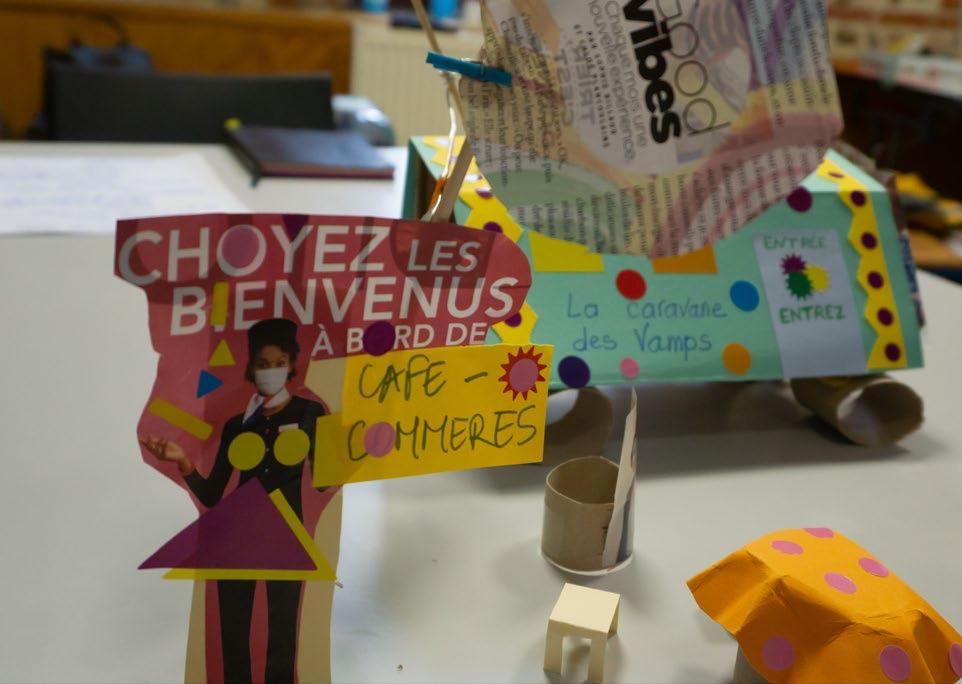
3 minute read
Boxes for NGOs
Within the framework of our missions, we support the ITEP teams in integrating the challenges of this evolution. The idea was to use a playful method that allowed medical and social workers to think how the regulatory changes would affect their organization. “Boxes for NGOs" is a prototyping method based on the expression of staff members’ representations of what their organization’s missions are and the building of a common representations of future. We also use this method with other NGOs to reflect on their strategy, their activities or with consortia to reflect on solutions to community needs.
How are citizens/learner engaged?
Advertisement
The method is based on the active participation of all participants. Divided into groups of a size that favours exchanges (5 to 6 people), different stages are proposed to support the collective construction: listening to the different points of view, exchanges, construction of the prototype by relying on the creativity and skills of the different members of the group.
Pedagogic /methodological aspects
The practice work in 3 steps. 1/ The group exchanges base on questions grid: 1 time of individual and collective reflection 2/ The group builds a physical representation with different materials (boxes, threads, postit, stickers…): 1 time to produce a prototype 3/ The group presents their collective physical representation: 1 time to present their prototype and 1 critical return time from other participants
SWOT
Strength • Collective reflection, • Low-cost approach, • Each one brings something to the approach, Organization and country: IpsoFacto, France Target group: social workers Age group: Every Age Context / Learning environment: Training and organization accompaniment Formal or non-formal education References, Link to the practices: www.ipsofacto-co.fr
• This allows each person to express his or her point of view and obliges others to hear it as follows, • Everyone expresses their creativity and their manual and design skills. Weakness Participants may lack confidence in their creativity and skills. Opportunities • Hear the representations of everyone, whatever their function • Getting to know each person's skills. • Makes the representation of the organization concrete and visual Threats • Commitment deficit • People's behavior: managing conflicts, controversies (not taking them into account), …
Which aspects are transferable?
The whole practice is transferable. The element to be adapted is the questions grid to support the individual and collective exchanges before the prototyping.
What kind of change is created?
This approach motivates participation of medical and social workers in the modification and improvement of their organization: the conditions of support for children and young people are more adapted to their needs. They are engaged and involved in the changes to implement. .
Making it mobile
We regularly use this method and find it particularly effective in identifying changes in organizations or services. I remember a particularly successful experience. An NGO was operating in an old building. At the seminar, the 4 teams represented small units spread around the city and even a mobile unit in the form of a camper van. The evolution of the organization was established. In addition to management and operation, it was the architectural project that would have to be rethought.
Conclusion:
Boxes for NGO sis a smart practice easy to implement. Participants are generally happy of the results they have in a short time. It is transferable, suited to many target groups, needs and circumstances.




Actionbound for remote participative walks
Martin Barthel

Organization and country: CRN, Germany Target group: All citizens Age group: 12+ Context / Learning environment: non-formal education References, Link to the practices: www.kieztraum.de Short description
What was the motivation to establish it? Target groups, transferable to national, international or local focus?
In 2020 CRN collected in the project Kieztraum perspectives and ideas of the citizens of the Pankstraße area in BerlinWedding. The process included the collection of placesa with positive emotions, but as well a collection of stories and insights of local citizens on what makes them happy and sad in their neighbourhood.
Due to the pandemic lockdowns, those stories however, could not be anymore collected face-to-face and additionally guided walks to


